|
|
News and details on Toy Story 2 - most recent articles at the top
- MAGAZINE COVERAGE
Source: Computer Graphics World, November 1999
There is a 5 page article in Computer Graphics World, November 1999 detailing Toy Story 2. Some of it's technical content has been included here. - COMPLEXITY OF TOY STORY 2
Source: Computer Graphics World, November 1999
"Toy Story 2 is twice as complex as A Bug's Life, which was 10 times more complex than Toy Story," says Ed Catmull, Pixar's founder and chief technology officer. - PRODUCTION PIPELINE
Source: Computer Graphics World, November 1999
Pixar used Alias Wavefront's Alias Studio for modeling, Interactive Effects' Amazon Paint for painting, and a host of custom software for such taks as modelling, animation, and compositing. Rendering performed using Renderman. - PIXAR'S RENDERFARM
Source: Computer Graphics World, November 1999
Pixar's Renderfarm running on Sun machines has now grown to 1400 processors. Toy Story 2 pushed the farm to the limit. - NUMBER FRAMES IN MOVIE
Source: Computer Graphics World, November 1999
There are 122,699 frames in the movie. - RENDERING TIMES PER FRAME
Source: Computer Graphics World, November 1999
Ranged from 10 minutes to three days - FRAME SIZE
Source: Computer Graphics World, November 1999
Up to 4Gb - FASTEST OUTPUT IN ONE WEEK
Source: Computer Graphics World, November 1999
14,880 frames of animation - ANIMATION TIMELINE
Source: Computer Graphics World, November 1999
Animation on Toy Story was finished in August. Movie released on 24 November 1999. - CHARACTER LIST IN MOVIE
Source: Computer Graphics World, November 1999
Wheezy - an asthmatic toy penguin with a broken squeaker.
Buster - the family dachshund.
Al - of Al's Toy Barn, a broker of toy collections.
Jesse - a cowgirl from Woody's Roundup.
Pete - a prospector from Woody's Roundup.
Bullseye - Woody's horse from Woody's Roundup. - AL'S MODEL FILE SIZE
Source: Computer Graphics World, November 1999
"If I had to make a rough guess, I'd say that all the source files that make him up come to 200Mb. Woody is about a tenth of that" Eben Ostby, modelling supervisor. - AL'S SKIN
Source: Computer Graphics World, November 1999
Subdivision-surface technology was used to create the skin for Al. The skin was specified using a giant Renderman shader that could create such skin characteristics as pores, blotchiness, veins, shininess, sweat, and even whiskers that the shader could grow procedurally. - AL'S HAIR
Source: Computer Graphics World, November 1999
Some hair is modelled using geometry, using an Alias plugin. This plugin allows the TDs to specify guide hairs for the look and movement of thousands of hairs once rendered. For other sections of hair, texture maps are used. - HUMAN CLOTHES
Source: Computer Graphics World, November 1999
A full dynamic cloth simulation was not developed. Instead the cloth was sculpted into place. It was decided to model the creases and folds for certain poses, then use shape interpolation between the changes in position. - GEOMETRY, GEOMETRY, GEOMETRY
Source: Computer Graphics World, November 1999
Galyn Susman, supervising technical director "In a Bug's Life, the complexity was in the surfaces. In Toy Story 2 the complexity is in the geometry". The two most geometrically-complex scenes take place in downtown and in an airport. - GEOMETRY IN DOWNTOWN
Source: Computer Graphics World, November 1999
Every block had 10 trees or more, every tree has thousands of leaves, every car has one or two people, and every person has thousands of hairs. Then there are buildings, grates, stoplights, and parking meters. The buildings have facets and windows with dirt on them. "None of it is fake, it's all geometry - Galyn Susman, supervising technical director. - OBJECT COUNT
Source: Computer Graphics World, November 1999
To create Toy Story the studio used 366 objects. In Toy Story 2 there are approximately 1200 models that range in size from a pencil to an airport. - GEPPETTO
Source: Computer Graphics World, November 1999
To help the animators create performances for the extras, the R&D department developed new articulation controls for the models. Called "Geppetto" the software evolves from Pixar's proprietary "PET" (Patch Editing Tool) technology.
"Gepetto is a way of grouping points and tying an articulated variable to them", explains Susman. "It gives us a way to build armatures and transfer them from character and to define what happens procedurally." With Geppetto, a modeller could import an entire armature to another human, and it would need only fine-tuning to accommodate different sizes. - RECREATING THE 1950s
Source: Computer Graphics World, November 1999
To recreate a television shot from Woody's TV show in the 1950s, the required animation was rendered in colour, converted to NTSC black-and-white video, then run through a compositor to add jitter, negative scratches, hair, coffee stains, scan lines, video bloom, and static. The result is warped to fit onto the television screen Woody is watching. - DUST WITH NO PARTICLES
Source: Computer Graphics World, November 1999
The dust on Wheezy's shelf is created using millions of pieces of stuff - not particles. In fact there are 2.4 million pieces of stuff, including tiny "hairs" - two-or-three pixel-wide flecks, and little spheres. - COMPLEX SPACE SEQUENCES
Source: Computer Graphics World, November 1999
In one shot, Buzz is surrounded by 280,000 individual articulated robots all shooting at him at the same time. - IF FAR AWAY, DON'T DRAW
Source: Computer Graphics World, November 1999
Pixar developed a scheme for optimising production including automatically generating details depending on how close a model is to the camera. "A human might have 200,000 hairs, but if the camera is very close or very faw away, you only need to use 500". - DIGITAL COLOUR TIMING
Source: Computer Graphics World, November 1999
"When we did the first Toy Story, we had the idea that once we were in production, we wouldn't change software" Ed Catmull says. "It turns out that's incorrect. We have to change. So we worked out methods for allowing that change." - MORE TOY STORY 2 GAME DETAILS
Source: GameOver, .tv, 11th November 1999
The Toy Story 2 game will be in the style of a 3D adventure where the gamer moves around and sees the world from a toy's perspective. - CHARACTER INFO
Source: Melanie Schneitkart, 14th January 1999
There may be a troll character in the movie. - TOY STORY 2 GAME
Source: Arcade Magazine, page 17, December 1998
There is a Toy Story 2 game in development. - CHARACTER INFO
Source: Rowena Mather, Toy Story fan, September 21st 1998
There are characters in Toy Story 2 called Prospector and Senorita Cactus involved and Emperor Zurg is also in it. There are new people providing voices and they are David Odgen Stiers, Joan Cusack, Estelle Harris and Wayne Knight. Woody's horse is called Bullseye. - PLOT DETAILS
Source: Rowena Mather, Toy Story fan, June 1st 1998
The name of the obsessive collector is Al. He steals Woody because he is worth lots of money and Al wants to sell him as a museum piece! Andy's gone away to summer camp at the time and the other toys need to rescue Woody before Andy gets home. - TOYS R BACK
Source: The Times, Metro Supplement, page 9, February 21-27th 1998
"To infinity and beyond!". In a break with tradition, Disney has announced a cinema sequel to its 1995 computer graphics hit, Toy Story. Up to now the animation studio has viewed follow-ups as a strictly straight-to-video business, a strategy which paid off with scaled-down but commerically successful continuations of Aladdin and Beauty and the Beast. Toy Story 2 was conceived to be one of those video blockbusters, but Disney bosses are so thriled with early rushes they have insisted the feature-length toon be re-thought as a theatrical release for Christmas 1999. Tom Hanks will once again provide the vocals for the churlish cowboy doll Woody, who this time gets kidnapped by an obsessive collector, prompting a rescuse bid by nice-but-dim Buzz Lightyear and the rest of the gang from the toy box.
|
|

Image of Al McWhiggin showing his complex skin including five o'clock shadow, blotchy skin, a small scar, whiteheads, and hair.
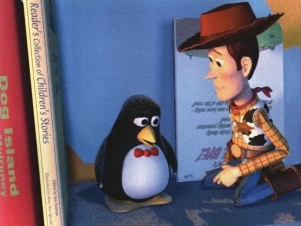
Covered with dust, Wheezy tells Woody that he's been forgotten. The dust is geometry, not a particle effect.
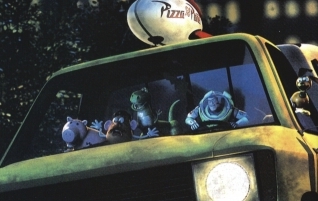
Lighting conditions in Toy Story 2 range from bright daylight to nighttime scenes such as the one in which Buzz and the toys race to Woody's rescue in a Pizza Planet truck.

Buzz planning Woody's rescue.

To create a crisp leading edge on the glowing engery balls, the effects team blurred the objects one-half frame backward in time.
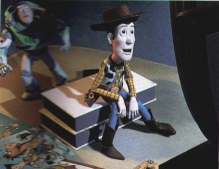
The light shining on Woody's face emulates the particular color of light emitted from a black-and-white TV set in the 1950s.

An image showing yellow printed material, little stratches, and paint worn off metal surfaces.

A collection of characters from Toy Story 2.

Andy's toys on the way to Al's Toy Barn.
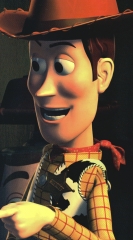
An image of Woody.

Toy Story 2 storyboard sketch. From Bill Malloy

Toy Story 2 storyboard sketch. From Bill Malloy
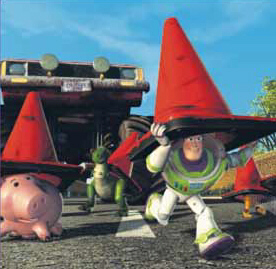
Another Toy Story 2 Picture. From Bill Malloy
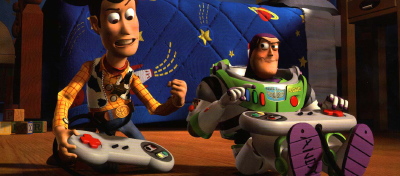
High Resolution still from Toy Story 2. From Bill Malloy, Paul Smith, and Sam
Click to enlarge to full size
A little more information

Pencil Sketch of Buzz Lightyear. From Bill Malloy

Pencil Sketch of Mr and Mrs Potato-head. From Bill Malloy